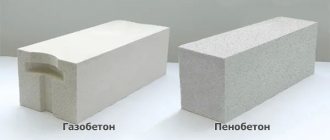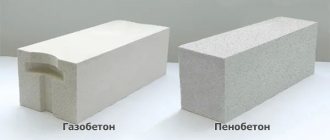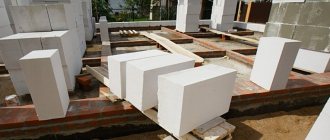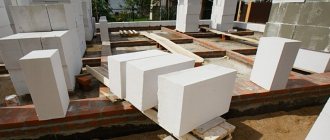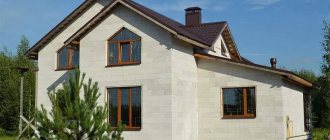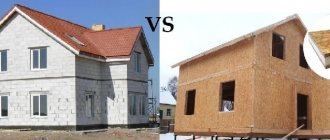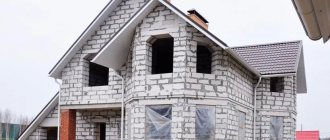In the cellular concrete segment, two popular materials compete – foam concrete and aerated concrete. When planning the construction of a house, cottage, garage or bathhouse, each owner tries to take into account all the nuances, predict various situations, estimate the cost, in general, create the most realistic plan before starting work.
The first and important task is the choice of material for load-bearing walls. What is better to build a house from, foam block or gas block? Each of them has its own positive and negative reviews.
Foam concrete or aerated concrete – which is better for building a house?
Cellular concrete is a group of building materials made from concrete and various additives that give it a porous structure. The most famous representatives of this type are aerated concrete and foam concrete.
At first glance, these are identical materials. However, there are also differences that form distinctive properties, which are the stumbling block between supporters and opponents of these materials.
To make an objective conclusion and make the right choice, we suggest that you familiarize yourself with the difference between a gas block and a foam block - a comparison of characteristics, properties and price. To do this, we will study all stages of the life cycle of these wall materials, starting from the technological production process, ending with decorative finishing, i.e. Let's conduct a full comparative analysis.
We recommend material on the topic:
Pros and cons of aerated concrete houses + reviews from owners
Pros and cons of foam concrete houses + reviews from owners
and
Advantages and disadvantages of foam concrete blocks + which one to choose
Comparison of which is better: foam blocks or gas blocks
Features of masonry work
All wall materials belonging to types of cellular concrete are laid using a similar technology.
Let's briefly consider the order of work:
- The first row of blocks is laid on the mortar in order to improve the adhesion of the base and the strength of the structure.
- The laying begins from the corners that will serve as beacons. The tallest one is chosen first.
- A construction thread is stretched between the products laid in the corners. If the length of the wall is more than 4-5 meters, the installation of additional guide blocks is allowed and even recommended.
- After completing the above steps, the first row is laid out completely.
- If there remains a gap that does not fit the size of the block, then the products are cut, usually using a hacksaw.
- Between the first and second rows, as well as every time after laying every 4th row, reinforcement must be made.
- The second and subsequent rows are laid mainly on glue, maintaining a small layer thickness in order to minimize cold bridges.
Advice! Be sure to start laying the second row with the seam offset by about 20-25%.
- Correction of evenness of block laying is carried out using a building level and a rubber hammer.
- The glue is usually applied using a trowel.
Note! The adhesive solution sets quickly enough and you will have no more than 10-15 minutes to make adjustments. In the future, it will no longer be possible to disassemble or repair the wall.
As for masonry work, there is no difference between the use of materials.
Production of foam concrete and aerated concrete
Comparison within the framework of manufacturing technology (production)
Compound
Both materials are produced by mixing concrete with materials that give it a porous structure.
But, in the production of foam concrete, such a material (foaming agent, plasticizer) is wood saponified resin (WRS), and aerated concrete is pulverized aluminum.
Manufacturing technology
Foam concrete is produced in the form of separate blocks. In this regard, the variety of its sizes and types is limited.
Aerated concrete is produced in a mass, which, after hardening, is cut into blocks of a given size and configuration. Thus, a greater geometric diversity of elements in size is achieved.
Production
Aerated concrete blocks are produced only in factory conditions using specialized equipment.
Foam concrete can also be produced in small enterprises (mini-factories, installations, artisanal, private production).
Pores (cells)
Due to the nature of production, the pores on the outer surface of the aerated concrete block remain open, which makes it look like a sponge. During a day in water, aerated concrete gains up to 47% moisture. Those. becomes almost twice as heavy. the material is unprotected from moisture or precipitation. If you add frost to this, then an unprotected aerated concrete wall will quickly become covered with a network of small cracks, which can be eliminated in various ways.
The pores of the foam concrete block are closed throughout the mass. This gives it hydrophobic properties. Foam concrete is like a float - it will float on the water for a long time.
As user tests show, foam concrete that has stood (gained strength) for a month (recommended time) is able to stay on the surface of the water for more than a month.
Foam blocks
Signs of foam material: gray color, smooth surface, closed porous cells. The composition of foam concrete includes:
- Portland cement;
- water;
- special chemical additives.
Advantages:
- High frost-resistant, heat-protective characteristics.
- The closed pore structure does not allow moisture to pass through.
- Has good strength. Although compared to aerated concrete, the strength is lower.
Minuses:
- Chemical foaming agents are used to create porosity.
- Imperfect geometric shape.
- The structure of the foam block is subject to temporary changes.
Return to contents
Production
First, using an industrial mixer, a regular cement mortar is prepared, the ratio of the components is maintained according to the future strength. Foam is added to the mixed mixture and mixed thoroughly. After which the finished solution is distributed into molds. Foam concrete blocks gain strength and harden under natural conditions. The initial setting of the mixture occurs in the first hours after distribution of the solution. Then the foam blank is loaded onto a pallet and removed for subsequent drying. The drying process takes 2 to 3 weeks. This time is enough to allow the foam block to be used for construction. The foam block gains its final strength in six months.
Return to contents
Characteristics of foam concrete and aerated concrete
Side-by-side comparison within material properties and characteristics
Pore sizes
Aluminum powder or paste, distributed over the aerated concrete mixture, allows you to obtain bubbles of the same size - pores.
In foam concrete, the pores are different in type (volume). Material prepared for the website www.moydomik.net
Density
The same for foam concrete and aerated concrete, it ranges from 300 to 1200 kg/m3 and depends on the brand. For example, brand D 500 has a density of 500 kg/m3 at the natural moisture content of the material;
Weight (whichever is heavier)
The weight of cellular concrete also depends on the brand. For example, 1 cubic meter. material grade D 500 will weigh 500 kg.
Strength (which is stronger, stronger)
For aerated concrete, it is uniform throughout the entire volume of the block, while for foam concrete it is non-uniform, which is due to the specific distribution of the foaming additive.
In addition, foam concrete and aerated concrete have low bending strength. This puts forward additional requirements for the construction of the foundation and its ability to ensure the dimensional stability of the house (prevent uneven shrinkage).
Strength gain
Aerated concrete has a maximum density (corresponds to the brand) in the early stages of production. During storage of gas blocks or operation of the building, it decreases.
Foam concrete, on the other hand, needs at least 28 days from the date of production in order to reach the declared density. This puts forward special conditions for the start of construction work.
To make sure that the block has gained strength, it is better to purchase it in advance and store it at the construction site for a month. Otherwise, a structure built from freshly made foam concrete will experience significant shrinkage. It is worth noting that foam concrete gains strength with use. That is, the older the block or house made of foam concrete, the stronger it is.
Size (geometry)
Due to the fact that aerated concrete is cut and not poured into formwork, its dimensions are much more accurate. This helps to achieve a smaller thickness of the masonry seam (2-3 mm) and reduce the area through which heat escapes to the outside (cold bridges).
The thickness of the foam block seam varies widely and is 2-5 mm. To a large extent, the thickness of the seam is determined by the skill of the masonry worker.
Moisture absorption
The ability to absorb water is greater in aerated concrete, which is due to the presence of open pores.
Thermal conductivity (which is warmer)
With the same density (brand of block), foam concrete and aerated concrete retain heat differently.
Aerated concrete is a better heat insulator than foam concrete. For example, a sufficient wall thickness for Moscow and the Moscow region when using D 500 foam block will be 600 mm, when using aerated concrete, only 450 mm.
Laying foam concrete and aerated concrete
Comparison of differences within the construction process (installation, laying, processing)
Foundation requirements
They are identical, since both types of cellular concrete are lightweight. However, an unprotected aerated concrete block, after getting wet, becomes almost half heavier, which creates additional pressure on the foundation. Foam concrete does not have this feature.
Cutting, sawing, drilling blocks and additional elements
They are identical; thanks to their structure and composition, cellular concrete blocks can be given the desired shape using a regular hand saw. Drilling, punching a hole or groove (groove) is also easy.
Speed of construction (laying, installation)
The low weight of both materials being compared makes the construction process quick and simple, compared, for example, with piece bricks.
Requirements for mortar and adhesive for installation
For aerated concrete, you need to use a special adhesive mixture, this allows you to reduce consumption and ensure a thin seam.
Foam concrete can be laid on glue or sand-cement mixture.
Protection (preservation)
If there is a need to suspend or stop construction work, for example, in the winter, the materials need to be preserved. At the same time, walls made of foam blocks will last for a certain period without problems, but walls made of aerated blocks need to be wrapped in film so that they do not absorb moisture. Moreover, aerated concrete needs protection at any time of the year. Of course, in the summer this is not so critical, a wall made of aerated concrete will dry out in a week or two (is it worth interrupting work for so long?), but in the winter this getting wet followed by freezing and thawing can lead to destruction;
Shrinkage
Foam concrete can shrink within 1-3 mm/m.m., shrinkage of aerated concrete does not exceed 0.5 mm/m.m.
Ability to hold fasteners
For both materials, you need to use special fasteners (hardware, screws, chemical anchors). They are designed specifically to be fixed in walls made of blocks with a porous structure.
Finishing of foam concrete and aerated concrete
Comparative analysis within finishing materials and works
Finishing material
For cladding aerated concrete and foam concrete walls (facade), you can use: siding, lining, plaster, ventilated facade.
Insulation material
Due to the fact that the pores of foam blocks and gas blocks contain air, they are good heat insulators. Therefore, a house made of aerated concrete or foam concrete does not need insulation (if the walls are sufficiently thick). If such a need arises or, for example, a bathhouse is built from these materials, only flexible insulation should be used.
Plaster mixture
For foam concrete and aerated concrete, you need to use special mixtures. The main advantage of plaster for cellular concrete is that it retains the ability to breathe. At the same time, the requirements for plaster for foam concrete also consist in the fact that the composition must have good adhesion to the surface.
Plastering technology
The more porous structure of aerated concrete gives it greater adhesion to any plaster.
Foam concrete requires the use of a reinforcing mesh in order for the plaster to hold securely. As an alternative, craftsmen advise treating the surface of the foam block with a float or sandpaper.
How to distinguish a foam block from a gas block?
You can distinguish a foam block from a gas block by the size of the pores. For a gas block they are small, for a foam block they are larger.
The color of aerated concrete blocks is white, the surface has roughness and relief. Foam blocks are smooth to the touch and have a gray tint. Knowledge of these nuances will help beginners distinguish between these two materials by appearance.
Due to their closed pores, foam blocks have excellent heat and sound insulation qualities. In addition, the material does not absorb water, but at the same time needs to be treated with special water-repellent compounds.
Gas blocks for building a house, which have small pores with microcracks, are more susceptible to the destructive effects of moisture, so the blocks must be covered with waterproofing substances.
The strength and reliability of each material can only be judged in practice. As the theory goes, strength is directly proportional to the density of the material. But in fact, even fragile at first glance, aerated concrete is in no way inferior in strength to foam block.
Cost of foam concrete and aerated concrete (which is cheaper)
Foam concrete is 20% cheaper than aerated concrete of the same brand. It is cheaper because... Cheaper materials and equipment are used in its production. This also leads to the appearance of a large amount of falsified material.
However, when calculating the cost of construction, you should not take into account only the purchase price of the blocks. It is also necessary to take into account the price and consumption of the adhesive mixture, finishing materials, the need for additional materials (rebar, reinforcing mesh, additional insulation, water repellents, etc.). Only after this can we say with confidence whether aerated concrete or foam concrete is cheaper.
Comparison of foam concrete and aerated concrete - which is better (table)
The table compares the main parameters that determine the properties of gas blocks and foam blocks. As a result, it is possible to determine which material to choose for construction under given conditions and requirements.
| Parameter | Foam concrete | Aerated concrete |
| Pore-forming additive | wood saponified resin (classified as moderately hazardous substances) | pulverized aluminum |
| Manufacturing technology | Block casting | Block cutting |
| Variety of elements | Less | More |
| Manufacturing | Handicraft production possible | In factory conditions |
| Pores | Closed | External - open, internal, mostly closed |
| Pore sizes | different sizes | same size |
| Block sizes | ||
| height (thickness) | 200, 300, 400 | 200 |
| length | 600 | 500, 600 |
| width | 100-300 | 75-500 |
| Density, kg/m3 | 300-1200 | |
| Weight, kg/m3 | 300-1200 | |
| Compressive strength, for grade D500 | IN 1 | B 2.5 |
| Strength gain | Does not correspond to the calculated one, with further recruitment | Instant with further loss |
| Size Accuracy | Objectively existing errors | Minimum error |
| Moisture absorption | Less | More |
| Frost resistance, cycles | F-30 | F-25 |
| Thermal conductivity, W/M*k | 0.08 (thermal insulation) – 0.36 (structural) | 0.1 (thermal insulation) - 0.14 (structural |
| Appearance | Worse | Better |
| Foundation requirements | identical | |
| Easy to install, cut, drill | identical | |
| Requirements for the adhesive mixture | Any | Only special mixture |
| Wall protection | Need not | Need |
| Shrinkage, mm/m.p. | 2-3 | 0,5 |
| Ability to hold hardware | identical | |
| Finishing material | Any | Allowing you to maintain the ability of the block to “breathe” |
| Insulation material | Preferably soft insulation (if necessary) | |
| Plastering | More difficult due to the smooth structure of the block | Simple |
| Price, rub/m3 | 2200-2800 | 3200-3500 |
Bottom line
As you can see, there is no clear answer to the question of which is better, aerated concrete or foam concrete. Based on this table, we can conclude that foam concrete and aerated concrete have significant differences that do not allow them to be put on the same level. Despite this, the general conclusion will be: aerated concrete has the best strength indicators, foam concrete in all other respects. Which criterion is more important depends on the specific situation, region and construction budget. Accordingly, everyone decides for themselves whether to build a house from foam blocks or gas blocks.
Shrinkage parameters
The manufacturing features of the material, which determine the structure of the massif, affect the shrinkage of the composition during masonry. When using gas concrete or foam block for the construction of a building, developers are interested in the absence of cracking of the walls, because this reduces the strength characteristics of the building. The amount of shrinkage depends on the tendency of the material to crack, hygroscopicity and hardness of the massif. The amount of shrinkage is:
- no more than 0.5 meters per 1 meter of masonry being erected - for gas concrete;
- up to 3 millimeters per meter of wall being built - for foam composites.
Foam blocks have lower strength with identical density due to different manufacturing technologies

